 The whole platform was just passed by the convention and released. Here are the sections on K-12 education (for highlights go to the Politics K-12 blog):
The whole platform was just passed by the convention and released. Here are the sections on K-12 education (for highlights go to the Politics K-12 blog):
Education: A Chance for Every Child
Parents are responsible for the education of their children. We do not believe in a one size fits all approach to education and support providing broad education choices to parents and children at the State and local level. Maintaining American preeminence requires a world-class system of education, with high standards, in which all students can reach their potential. Today’s education reform movement calls for accountability at every stage of schooling. It affirms higher expectations for all students and rejects the crippling bigotry of low expectations. It recognizes the wisdom of State and local control of our schools, and it wisely sees consumer rights in education – choice – as the most important driving force for renewing our schools.
Education is much more than schooling. It is the whole range of activities by which families and communities transmit to a younger generation, not just knowledge and skills, but ethical and behavioral norms and traditions. It is the handing over of a personal and cultural identity. That is why education choice has expanded so vigorously. It is also why American education has, for the last several decades, been the focus of constant controversy, as centralizing forces outside the family and community have sought to remake education in order to remake America. They have not succeeded, but they have done immense damage.
Attaining Academic Excellence for All
Since 1965 the federal government has spent $2 trillion on elementary and secondary education with no substantial improvement in academic achievement or high school graduation rates (which currently are 59 percent for African-American students and 63 percent for Hispanics). The U.S. spends an average of more than $10,000 per pupil per year in public schools, for a total of more than $550 billion. That represents more than 4 percent of GDP devoted to K-12 education in 2010. Of that amount, federal spending was more than $47 billion. Clearly, if money were the solution, our schools would be problem-free. (more…)